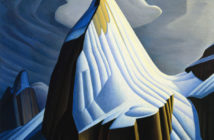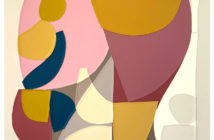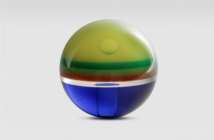Dear Artist,
In the summer of 1916, John Singer Sargent wrote to his cousin Mary: “Two things here get on my nerves — one the roaring and hissing and pounding all night long of a tremendous waterfall that I am near, the other the alighting of snowflakes on my bottom when it is bared once a day. Perhaps this is the poetry of camping out.”
I’m writing to you from the exact spot at Lake O’Hara in the Canadian Rockies where Sargent did his complaining. I, too, have complaints: In this alpine hut 16 humans are required to sleep side by side 8 to a shelf. The odds that there are accomplished snorers among such a group are high, and these nights provide no exception. Another complaint is that canvases keep falling from my easel and landing face down on my palette. Poetry not mentioned in art school.
But there’s another complaint that makes all other complaints trivial. It’s a complaint about myself. It’s that I have not taken the time to see enough places. It’s that I have not yet truly appreciated the diversity and complexity of our world. This spot is a pristine valley with shimmering, turquoise lakes, massive, snow-dressed mountains catching clouds and shards of light, spirited waterfalls and bubbling streams, ancient mossy rocks of tender and sophisticated colour, all held together in a mighty bowl in which one can inhale the volume.
What a privilege to be with creative and observant companions past and present. To see and share an environment where sheer power and the delicate flower beg to be studied and honored. To be surprised and delighted at every turn of a path. To flirt with the gods of the larch forest and the granite mountains. To be in a place where human understanding is submissive to impression. What a high it is to be an artist. What a responsibility. How natural. How tragic it might have been to pass this one up. My complaint is that I almost did.
Best regards,
Robert
PS: “One felt that the mountains are not completed. The builders are still at work. Stones come rolling and jumping from the upper scaffolding and often from the chasms one hears the thundering as the gods of the mountains change their minds.” (J.E.H. Macdonald)
Esoterica: We’re finding the exact spot where Sargent painted “Lake O’Hara.” It’s 37″ x 57″ — surprisingly large for outdoor work. It’s now in the Fogg Museum in Cambridge, USA. The largest canvas I have with me is a 20″ x 24″. In places like this we load our brushes with humility. What a feeling it is to simply run the eyes over timelessness.
The following are selected correspondence arising from the above and other letters. Thanks for writing.
High and wild places
by Alice Saltiel-Marshall, Canmore, Alberta, Canada
As I began to read the Sargent quote I knew exactly where you are. I have seen his painting in the flesh and it is enough to make you weep. Isn’t it rich at O’Hara? To be and paint where others have before and will again. Layers of art and time wrapped in spirit. Privileged is indeed the right word. I have slept on that shelf. I have stood in the mouth of the crystal cave looking out at brooding weather. Been blinded by screaming yellow larches and moved by the large and small wonders of O’Hara. All times spent there are permanently etched in my memory but none more than the painting days. Next month I won’t paint there but I will go up beyond Oesa to the Abbot Hut. This will be another first and my heart will explode the way it always does when I get to high and wild places.
Nature’s varnish
by Audrey Pfannmuller, Camrose, Alberta, Canada
You are visiting one of my favorite spots in the Rockies. I have been there many times yet not enough. I was there recently and in the rain and without my camera. I was given the delight of really seeing the rocks in all their glory. I’m talking about those that support us on the climb to the top. With nature’s varnish making those colors come alive, there was no way that a camera could begin to catch the glory of all that color. It is going to be great to pull from memory. One cannot miss Lake O’Hara.
Soul renewed
by Linda Wadley, Jasper East, Alberta, Canada
I was there in autumn and the larch were yellow and some were the soft pea green colour of spring. The hiking, the sore feet, showering at night in the tall spruce trees from the bag of warm water heated by the sun on the picnic table, the Alpine glow over the mountains where you had just been, crawling into your sleeping bag amongst strangers who had become family. We stopped for short breaks to paint. My watercolour sketches will one day turn into oils. In the meantime I dream of going back again to have my soul renewed.
We notice things more deeply when we travel
by Eleanor Blair, Gainesville FL, USA
I had a studio party yesterday in order to show paintings of my recent trip to Ireland. One of my favorite paintings is of a cup of tea. Someone at the show asked, “How is a cup of tea in Ireland any different from a cup of tea at home?” I look at my painting, and remember my day in Dublin. I remember the sudden rain. I ducked into a sidewalk cafe, and ordered some tea to give me an excuse to enjoy some shelter from the weather. Students from Trinity College sat around me, studying, all with their own cups of tea. Why do artists like to travel far from home to paint? We find the same things to complain about, and the same comforts. Maybe we just notice everything more deeply when we travel. And that’s the stuff that art is made of.
Sargent’s guide in the Rockies
by Charles Edmunds
In 1965 I traveled to Bow Lake and was welcomed by Jimmy Simpson. We talked and looked at his watercolors in his octagon shaped studio. Jimmy lived his entire life in the Rockies. I oohed and aahed at his sketches and he presented me with a watercolor. He told me that he led Sargent into Lake O’Hara with several pack animals. (Sure thing with a Canvas that size! 37″x 57″) That very day I drove to Lake O’Hara and painted a watercolor of my own. At the Sargent show in Seattle in December 2000 a W/C of Sargent’s tent at Lake O’Hara shows a campfire and a young guide.
Travelling light
by Roger Marz
I have solved the easel problem. I carry everything I need in my vest. Four Faber Castel Pitt pens, thirty watercolor pencils, 4×6, 7×10 and 9×12 watercolor paper, three Cheap Joe travel brushes and three one ounce bottles of water (old hotel shampoo bottles.)
Strange mistress
by Jennifer Garant, Naramata, B.C., Canada
Creativity is a strange mistress. I think too complicated sometimes and other times perhaps too simple. Something obviously clicked on this trip — sleep deprivation may have lowered one awareness and at the same time heightened another. Deepak Chakra has claimed youth can be obtained and maintained through flexibility. “Be like a reed blowing in the wind”… Or maybe the great artists who went out painting in groups realized a new heightened creativity with a group consciousness. I feel myself painting like a lone cowgirl. I now have a new challenge. I will pass on the 8 to a shelf thing though.
Hotspot for creativity
by Maureen O’Leary, Palo Alto, California, USA
It is amazing to me how many of the artists that you mention have some link to where I grew up: Gloucester, MA. It wasn’t until I was an adult that I came to realize that I had been surrounded by genius. To me, as a kid, modeling for Leon Kroll, George Demetrious, Walker Hancock was a summer job. The anecdotes about Winslow Homer and Andrew Wyeth were just funny stories. Fitz Hugh Lane, Emile Gruppe, John Singer Sargent, The Folly Cove Designers, Paul Manship, Grafley, John Sloan were names you grew up with no different than other names you knew: Floyd the Clamdigger or Catnip Bill. The light off the water is what brought them all there. They enriched our lives. They lived gently and worked hard. You could set your watch by them they were so regimented in their work ethics. They were well-traveled and many had adopted European ways; they brought the big world home to our little rock island.
Packing and shipping
by Julie Rodriguez Jones, San Pablo, CA, USA
I have a question regarding packing art for shipping to galleries. I have an up coming show where the gallery has asked for seven pieces of art, one of which is 32 x 17 inches. Normally when there are shows I send two or three paintings but this time, they have asked for seven pieces and for me that is a bunch. I have been using reinforced cardboard boxes with the art placed in envelopes that I make out of a thin foam liner with bubble wrap around it. Nothing has been damaged to date. I usually use UPS with a check enclosed for any return freight. This time, I have a larger box (24″w x 20″d x 35″ high). (The box is actually a U-haul shorty wardrobe box.) For the additional padding, I have added bio-degradable foam peanuts encased in large plastic bags for the padding. Might you have a recommendation(s) for reusable containers that are fairly lightweight? Most galleries I have dealt with prefer to use UPS too. I’d like to stick with one box, if possible. (Perhaps the easiest solution is to send multiple containers.)
(RG note) In my studio we generally wrap each unframed canvas in brown paper and then put them into an appropriately sized “mirror box” with cardboard between. You can buy mirror boxes in several sizes at box suppliers. They are two corrugated cardboard boxes that slide into one another. Often, when the sizes are irregular, it’s a good idea to send more than one box. Sometimes we bubble-wrap as well. We have an account with Purolator Courier. We often also use UPS. We fill out the way-bill ourselves and give them a call when the package is ready. The call goes to a 1 800 number in some other city but the truck is sometimes at the studio door within minutes. Don’t ask me how. We always try to ship by air as the anguish is shorter. Later, the bill comes in the mail.
Shipping framed and glazed paintings is of course another kettle of fish. Properly padded wooden boxes may be necessary. There is a simple system for framed and glazed: maneuver the dealer into doing the framing. They make more money that way and the intelligent ones will generally go for it. Also, your favorite frame may not work in another market. Every city seems to have its own popular moldings and liner styles these days.
What is… is
by Carol Lopez
Regarding the quality-competence discussion, another possible way of thinking is that competence is for activities like bus driving or watch-making. It’s good to get really competent at those sorts of things, and it’s easy for onlookers to judge those types of activities. But with art, we don’t really need to judge, and when we do, we sometimes fall into a trap. Many groundbreaking artists, (like the impressionists) were called incompetent, but they hung in and eventually made quite a big splash. I would rather evaluate my art by noticing how I feel when I am doing it; am I moved, touched, or inspired? Do I finish a day of painting wishing it had 48 hours so I had more time to experiment further? This is the rush that has me realize what a privilege it is to be an artist. After all, there are thousands of artists in the world who are as competent as I am, so to try and compete with them is pointless. In fact, it’s children’s art that really touches me — but I hesitate to judge it for its quality. It’s not good or bad, it just is! What has been said about the meaning of life can apply to art: “What is… is.”
You may be interested to know that artists from every state in the USA, every province in Canada, and at least 100 countries worldwide have visited these pages since January 1, 2002.
That includes Sandy Sandy who quotes Kahlil Gibran: “All you have shall some day be given; Therefore, give now, that the season of giving may be yours and not your inheritors.”
And also Keith O’Connor who writes, “To prevent canvas from falling off the easel you can buy quick release plastic clamps shaped like pliers — very light — you may wish to consider using them to quickly clamp your canvas to your easel.”













1 Comment
Sargent’s guide in the Rockies
by Charles Edmunds
Webmaster: Please correct an error: The 4×6 Watercolor was painted by Jimmy Simpson .